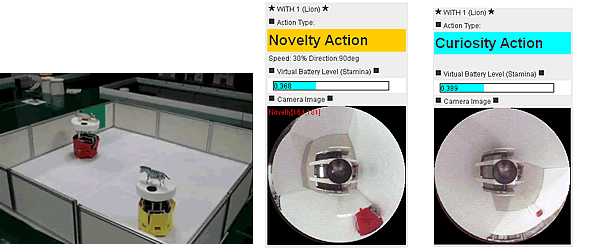 |
 |
 |
[ Brain-inspired emergence of behaviors based on values and curiosity in mobile robots ] |
 |
 |
Sub-project leader : Ishikawa |
|
 |
|
 |
 |
| (1) |
Overview
Our aim is to develop truly autonomous mobile robots which are capable of behaving without being told what to do not only at a concrete level but also at an abstract level. We believe a develop-mental approach is effective to realize this. The desire for existence, specific curiosity, diversive curiosity, and novelty are important factors contributing to learning and development. It is desired to introduce task independent internal rewards. We did not only simulation but also real experiments using reinforcement learning with external and internal rewards in a robotic field inhabited by a predator and its prey.
The desire for existence, here, is represented by keeping the level of a battery higher than a threshold. When the level of its battery is higher than the threshold, an agent efficiently learns the environment motivated by curiosity and novelty. Usually curiosity motivates the agent to learn the environment. When a novel object is observed, however, novelty motivates the agent to approach and to closely observe it. When the level of its battery is lower than the threshold, the predator starts to pursue its prey motivated by the desire for existence.
We realize emergence of intelligent behaviors based on external and internal rewards inspired by the brain and development, and also demonstrate superior performance in tasks such as learning of the environment which are meaningful from the viewpoint of engineering.
|
 |
| (2) |
Members of the project
Cooperation among researchers in different fields are realized: M. Ishikawa, M. Nagamatsu, and H. Zhang in a theory and models field, T. Yamakawa in a devices field, K. Ishii in a robotics field, and H. Nakagawa in a physiology field. Graduate students mainly in theory and models field, T. Hagiwara, N. Yamamoto, F. Kiriake, and T. Nishida, contributed to simulation and real exmeriments.
|
 |
| Page top ↑ |
| (3) |
Major results
 |
| Fig. 1 Action-value function obtained by reinforcement learning with the desire for existence as internal rewards |
 |
Fig. 2 The number of needed actions for capturing. Case 1: only the predator learns and the prey escapes simply in the opposite direction. Case 2: only the predator learns and the prey escapes in random direction. Case 3: Both the predator and prey learn. |
|
 |
 |
 |
Fig. 3 Robotic field
red: robot
blue: moving obstacle |
 |
Fig. 4 Potential map |
 |
Fig. 5 Occupancy grid map by the proposed |
 |
Fig. 6 Occupancy grid map by the conventional method |
|
 |
 |
 |
| Fig. 7 Robotic field with the predator and the prey |
 |
Fig. 8 Detected novel object |
 |
Fig. 9 Undetected novel object |
|
 |
 |
|
| Page top ↑ |
|
 |
Major publications For details, seehttp://www.brain.kyutech.ac.jp/~ishikawa/ For details, seehttp://www.brain.kyutech.ac.jp/~ishikawa/ |
| [1] |
Masumi Ishikawa, Masahiro Nagamatsu, Takao Hagiwara, Naoyuki Yamamoto, Fumiko Kiriake, Takehiko Nishida, Takeshi Yamakawa, Kazuo Ishii, Hideki Nakagawa, Hong Zhang, Brain-inspired emergence of behaviors based on values and curiosity in mobile robots (to appear in Brain-Inspired IT, IV)
|
| [2] |
M. A. Muslim, M. Ishikawa, T. Furukawa, Task segmentation in a mobile robot by mnSOM: A new approach to training expert modules, Neural Computing and Applications, Vol.16, Issue 6, pp.571-580, 2007.
|
| [3] |
M. A. Muslim, M. Ishikawa, T. Furukawa, Task Segmentation in a Mobile Robot by mnSOM and Clustering with Spatio-temporalContiguity (to appear in ICONIP2007 post-proceedings)
|
| [4] |
T. Furukawa, K. Tokunaga, S. Yasui, H. Tamukoh, K. Ishii, M. Ishikawa, K. Horio and K. Natsume, Modular network self-organizing map: Can it be an artificial cortex?, Brain-Inspired IT III, Volume 1301, pp. 43-47, 2007
|
| [5] |
M. Ishikawa, K. Ishii, T. Yamakawa, M. Nagamatsu, H. Nakagawa, H. Zhang and T. Furukawa, Brain-inspired emergence of behaviors in mobile robots, Brain-Inspired IT III, Volume 1301, pp. 48-51, 2007.
|
| [6] |
M. A. Muslim, M. Ishikawa and T. Furukawa, Training expert modules for a mobile robot using mnSOM, Brain-Inspired IT III, Volume 1301, pp.172-175, 2007.
|
| [7] |
F. Linaker, M. Ishikawa, Robot Localization Using Vision, Trends in Neural Computation, pp.483-512, Springer, 2007.
|
| [8] |
A. Ahrary, A. Nassiraei, M. Ishikawa, A study of an autonomous mobile robot for sewer inspection system, Artificial Life and Robotics, Vol.11, No.1, pp.23-27, 2007.
|
| [9] |
K. Kamei, M. Ishikawa, Dependency of values of parameters in reinforcement learning for navigation of a mobile robot on the environment, Neural Information Processing---Letters and Reviews, Vol.10, Nos.7-9, pp.219-226, 2006.
|
| [10] |
M. Ishikawa, N. Ide, S. Isomura, A method for object discrimination, recognition, an apparatus for object discrimination, and its program, Patent No. 3865316, 2006.10.13.
|
|
|
|